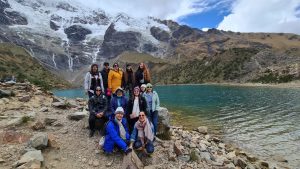In our hyper-connected world, the need for a digital detox has become more pressing than ever. With the constant bombardment of notifications, emails, and social media updates, many individuals find themselves yearning for a break from the digital frenzy.
This article explores effective travel tips for a successful digital detox in 2025, focusing on key aspects such as preparation, destination selection, and immersive experiences to ensure a rejuvenating and technology-free getaway.
Understanding Digital Detox
Digital Detox refers to a period during which an individual refrains from using electronic devices such as smartphones, computers, and tablets. The primary goal is to reduce stress, improve focus, and enhance mental well-being by disconnecting from the digital world.
Importance:
- Mental Health: Continuous exposure to digital screens and social media can lead to anxiety, depression, and a sense of being overwhelmed. Taking a break helps to mitigate these issues.
- Productivity: Overuse of digital devices often leads to distractions and decreased productivity. A digital detox allows for a more focused and efficient work ethic.
- Overall Well-being: Reducing screen time promotes better sleep, encourages physical activity, and enhances real-life social interactions.
Benefits for Mental Health, Productivity, and Overall Well-being
- Mental Health Benefits:
-
- Reduced Anxiety and Stress: Limiting exposure to social media and news reduces feelings of anxiety and stress associated with information overload.
- Improved Mood: Taking time away from screens can enhance mood and emotional stability.
- Productivity Benefits:
-
- Increased Focus: Without the constant interruptions from notifications and alerts, individuals can concentrate better on tasks at hand.
- Enhanced Creativity: A break from digital distractions can foster creativity and innovative thinking.
- Overall Well-being:
-
- Better Sleep: Reduced screen time, especially before bed, can improve sleep quality.
- Physical Health: Encourages engagement in physical activities, reducing the risks associated with sedentary lifestyles.
- Social Connections: Promotes face-to-face interactions, strengthening personal relationships.
Statistics and Trends
Current Statistics on Digital Consumption:
- Average Screen Time: On average, adults spend about 7-9 hours per day on digital devices, with significant portions of this time on social media and streaming services.
- Social Media Usage: Over 3.6 billion people use social media worldwide, with the average user spending around 2.5 hours per day on these platforms.
Trends Showing Increased Interest in Digital Detox Vacations:
- Rise in Wellness Tourism: The global wellness tourism market, which includes digital detox retreats, is projected to grow by over 7% annually.
- Google Searches: There has been a significant increase in Google searches for terms like “digital detox retreats” and “digital detox vacations,” reflecting growing public interest.
- Popular Destinations: Destinations offering digital detox packages, such as nature retreats and wellness centers, have seen increased bookings and interest.
Understanding and implementing a digital detox can lead to significant improvements in mental health, productivity, and overall well-being, making it a valuable practice in today’s digitally saturated world.
Preparing for Your Digital Detox Journey
Setting Intentions and Goals
- Defining Personal Reasons for a Digital Detox: Reflect on why you need a break from digital devices. Are you seeking to reduce stress, improve sleep, reconnect with nature, or enhance personal relationships? Understanding your motivations will help you stay committed.
- Setting Realistic and Achievable Goals: Establish clear, attainable goals for your detox. These could be specific (e.g., no phone usage after 8 PM) or general (e.g., spending more time outdoors). Ensure your goals are practical to avoid feeling overwhelmed.
Planning and Packing Essentials
- Creating a Packing List Focused on Relaxation and Offline Activities: Plan what to bring to make your detox enjoyable and fulfilling. Focus on items that promote relaxation and engagement in offline activities.
- Essential Items:
- Books: Choose a variety of genres to keep you entertained.
- Journals: Use these for reflection, creative writing, or tracking your detox journey.
- Offline Maps: Ensure you have physical maps if you’re traveling to unfamiliar areas.
- Hobbies and Games: Bring board games, puzzles, or craft supplies.
- Comfort Items: Pack items like cozy blankets, comfortable clothes, and anything that helps you relax.
Informing Family and Friends
- Setting Expectations and Communicating Plans: Let your loved ones know about your detox plans. Inform them of your availability and how they can reach you in case of emergencies.
- Preparing for Emergency Contact Methods Without Digital Devices: Establish alternative methods for emergency communication, such as providing a landline number, sharing your itinerary with a trusted person, or setting up specific times for check-ins.
Embarking on a digital detox can be a refreshing experience, helping you to reconnect with yourself and the world around you. By setting clear intentions, planning effectively, and communicating with your loved ones, you can ensure a successful and enjoyable detox journey.
Choosing the Perfect Destination for a Digital Detox
Nature Retreats
Nature retreats offer a sanctuary from the hustle and bustle of daily life, allowing you to reconnect with the natural world and find inner peace. Here’s why they are perfect for a digital detox:
Benefits of Nature in Aiding Digital Detox
- Stress Reduction: Immersing in nature helps reduce stress levels and promotes relaxation.
- Enhanced Mental Clarity: Natural surroundings boost mental clarity and creativity, providing a fresh perspective.
- Improved Physical Health: Activities like hiking and walking in nature improve physical health and well-being.
- Better Sleep: Exposure to natural light and fresh air regulates sleep patterns and improves sleep quality.
Top Nature Retreats to Consider in 2025
- Banff National Park, Canada: Renowned for its stunning mountain scenery and pristine lakes, perfect for hiking and relaxation.
- Fiordland National Park, New Zealand: Offers dramatic landscapes with fjords, waterfalls, and rainforests for an immersive nature experience.
- Yosemite National Park, USA: Famous for its breathtaking cliffs, waterfalls, and giant sequoias, ideal for a serene getaway.
- Lake District, UK: A picturesque region with lakes, forests, and mountains, great for peaceful retreats.
- Blue Mountains, Australia: Known for its rugged cliffs, eucalyptus forests, and tranquil ambiance, perfect for unwinding.
Remote and Off-the-Grid Locations
Choosing remote and off-the-grid destinations allows you to completely disconnect from digital distractions and immerse yourself in solitude and tranquility.
Pros of Staying in Remote Areas with Limited Connectivity
- Complete Disconnection: Limited or no internet connectivity ensures a true digital detox.
- Increased Focus on Self-Care: The absence of digital interruptions encourages self-reflection and mindfulness.
- Enhanced Connection with Nature: Remote locations often offer unparalleled natural beauty and serenity.
- Opportunity for Adventure: Exploring off-the-beaten-path areas can be a thrilling and rewarding experience.
Recommendations for Off-the-Grid Destinations
- Svalbard, Norway: An Arctic archipelago offering stunning polar landscapes and the opportunity to see the Northern Lights.
- Patagonia, Chile and Argentina: Known for its dramatic landscapes, including glaciers, mountains, and vast wilderness.
- Namibia, Africa: Offers unique desert landscapes, wildlife, and starry skies, perfect for a secluded retreat.
- Tasmania, Australia: An island state with rugged wilderness, secluded beaches, and abundant wildlife.
- Mongolia: Vast steppes, deserts, and mountains, providing a truly remote and cultural experience.
Wellness and Meditation Centers
Wellness and meditation centers provide a holistic approach to a digital detox, focusing on mental and physical well-being.
Importance of Mental and Physical Wellness During a Detox
- Mental Clarity: Meditation and wellness practices clear the mind and reduce anxiety.
- Physical Health: Yoga, fitness classes, and healthy eating improve physical well-being.
- Emotional Balance: Mindfulness practices foster emotional stability and resilience.
- Spiritual Growth: Spiritual retreats offer opportunities for deep introspection and growth.
Popular Wellness Retreats and Meditation Centers
- Ananda in the Himalayas, India: A luxury spa and wellness retreat offering yoga, meditation, and Ayurvedic treatments.
- Miraval Resort & Spa, USA: Known for its comprehensive wellness programs, including mindfulness, fitness, and nutrition.
- Como Shambhala Estate, Bali: A holistic wellness retreat with personalized programs focusing on physical, mental, and spiritual health.
- Kamalaya, Thailand: Offers a range of wellness programs, including detox, stress management, and holistic health.
- Shambhala Mountain Center, USA: A meditation and retreat center offering mindfulness, meditation, and yoga programs.
Choosing the right destination for a digital detox is crucial for achieving the desired mental, physical, and emotional rejuvenation. Whether you opt for a nature retreat, a remote off-the-grid location, or a wellness center, each offers unique benefits that contribute to a successful digital detox.
Activities to Enhance Your Digital Detox
Outdoor Adventures
- Hiking, Camping, and Exploring Natural Landscapes
- Immerse yourself in the great outdoors by going on hikes, camping trips, and exploring scenic natural landscapes. Disconnect from digital devices and reconnect with nature.
- Benefits of Physical Activities in Reducing Digital Cravings
- Physical activities such as hiking and camping can significantly reduce the urge to check digital devices. The physical exertion combined with the calming effects of nature helps in breaking the habit of constant digital consumption.
Mindfulness and Meditation Practices
- Techniques for Mindfulness and Meditation
- Incorporate mindfulness and meditation into your daily routine. Techniques like deep breathing, guided meditation, and body scan meditations can help you stay present and focused.
- How These Practices Help in Maintaining a Digital-Free State
- Mindfulness and meditation practices train your mind to be present in the moment, reducing the need for digital distractions. These practices can help in maintaining a calm and balanced state, making it easier to stay away from digital devices.
Creative Pursuits
- Engaging in Art, Writing, and Other Creative Hobbies
- Take up creative activities such as painting, drawing, writing, or crafting. Engaging in creative hobbies provides a productive outlet for your energy and keeps your mind occupied.
- Benefits of Creative Activities for Mental Clarity and Relaxation
- Creative pursuits can enhance mental clarity and relaxation. They provide a therapeutic escape from digital screens and help in fostering a sense of accomplishment and satisfaction. Engaging in creative activities can also stimulate your imagination and problem-solving skills.
Managing Withdrawal Symptoms
Identifying Common Symptoms
- Anxiety, Restlessness, and Boredom
-
- These are frequent emotional responses when adjusting to changes in habits or routines.
- Anxiety can manifest as nervousness, worry, or fear about the change.
- Restlessness often involves an inability to relax or focus.
- Boredom may arise from the sudden absence of previously engaging activities.
- Physical Symptoms
-
- Eye Strain: Often a result of prolonged screen time, causing discomfort or headaches.
- Poor Posture: Extended periods of sitting or improper ergonomics can lead to back, neck, and shoulder pain.
Coping Strategies
- Mindfulness Techniques and Breathing Exercises
-
- Mindfulness: Practice staying present and aware of the current moment to reduce anxiety. Techniques include meditation, mindful walking, or simply focusing on breathing.
- Breathing Exercises: Simple exercises like deep breathing or the 4-7-8 technique can help calm the mind and body.
- Engaging in Physical Activities
-
- Exercise: Physical activities such as walking, jogging, yoga, or any form of workout can help distract the mind and release endorphins, which improve mood.
- Hobbies: Engaging in hobbies like gardening, cooking, or crafting can provide a productive and enjoyable distraction.
Seeking Support
- Joining Group Activities or Retreats
-
- Participating in group activities can provide a sense of community and shared experience, reducing feelings of isolation.
- Retreats: Consider attending retreats focused on wellness, mindfulness, or physical activity to immerse in a supportive environment.
- Finding Local Support Groups or Therapists
-
- Support Groups: Look for local or online support groups where you can share experiences and coping strategies with others going through similar changes.
- Therapists: Professional support from therapists or counselors can offer personalized strategies and emotional support during the withdrawal process.
By recognizing common withdrawal symptoms and employing effective coping strategies, individuals can better manage the transition and maintain well-being. Seeking support from groups or professionals can further aid in navigating this challenging period.
Reintegrating into Digital Life Post-Detox
Evaluating the Detox Experience
- Reflecting on Personal Growth and Changes
-
- Take time to journal or discuss with a friend how the detox period has impacted your mental health, productivity, and overall well-being.
- Identify specific positive changes in your behavior, mindset, or habits that emerged during the detox.
- Consider the skills or new hobbies you developed and how they contributed to your personal growth.
- Assessing the Benefits and Challenges Faced
-
- Make a list of the benefits you experienced, such as improved focus, better sleep, or enhanced personal relationships.
- Reflect on the challenges you encountered, such as initial withdrawal symptoms, boredom, or social pressure.
- Analyze how you overcame these challenges and what strategies were most effective.
Creating a Balanced Digital Lifestyle
- Setting Boundaries for Future Digital Use
-
- Define specific time slots for checking emails, social media, and other digital activities to prevent constant usage.
- Establish “no-tech” zones or times, such as during meals or an hour before bedtime, to foster healthier habits.
- Communicate your boundaries to friends, family, and colleagues to set expectations and reduce digital interruptions.
- Incorporating Regular Digital Detox Practices into Daily Life
-
- Schedule periodic mini-detoxes, like a tech-free Sunday or an hour of screen-free time each day.
- Engage in offline activities that you enjoyed during your detox, such as reading, exercising, or spending time in nature.
- Use mindfulness techniques, such as meditation or deep breathing exercises, to manage digital cravings and maintain balance.
Utilizing Technology Mindfully
- Tools and Apps that Promote Healthy Digital Habits
-
- Explore apps that track and limit screen time, such as Moment, Freedom, or Forest, to stay aware of your digital usage.
- Use productivity tools like Pomodoro timers to break work into manageable chunks and reduce digital distractions.
- Install apps that promote mindfulness and mental well-being, like Headspace or Calm, to integrate tech into your self-care routine.
- Strategies for Mindful Technology Usage
-
- Practice intentionality by asking yourself if a digital activity is necessary or beneficial before engaging in it.
- Focus on one task at a time and avoid multitasking with multiple devices to enhance productivity and presence.
- Curate your digital environment by unsubscribing from unnecessary notifications and following content that adds value to your life.
By reflecting on your detox experience, setting clear boundaries, incorporating regular detox practices, and using technology mindfully, you can create a balanced and healthy digital lifestyle.
Disconnecting from the digital world allows us to reconnect with our inner selves and the world around us. The long-term benefits of a digital detox include improved mental clarity, better sleep, enhanced relationships, and a greater sense of peace and contentment. By prioritizing time away from screens, we can cultivate a more fulfilling and mindful existence. Start your digital detox journey now and experience the profound impact it can have on your overall well-being.


